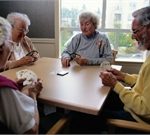(HealthDay News) — American ginseng is an herb that people take by mouth as a stimulant, to reduce stress, or to boost the immune system, says MedlinePlus. American ginseng has different medicinal effects from the Siberian and Asian varieties. Here’s what MedlinePlus says about American ginseng: Side effects may include diarrhea, itching, insomnia, headache and nervousness. Never take ginseng if taking warfarin (Coumadin). Use caution if taking ginseng with MAOIs, antidiabetes drugs or immunosuppressants. Do not take ginseng if you are pregnant.
A little about: Weekly Gravy
All Sauce from Weekly Gravy:
Birth Control Pill May Alter Part of Women’s Brains

A small, preliminary study suggests that a brain area called the hypothalamus appears to be about 6% smaller in women who use birth control pills. But exactly what that means isn’t yet clear. In this study, women on the pill had statistically significant increases in anger. Researchers also found a possible link with depression symptoms. The good news: They didn’t see any difference in women’s mental performance. And women who use the Pill shouldn’t search for other forms of birth control based on these findings, researchers said. “There isn’t enough data here for anyone to worry,” said study author Dr. Michael Lipton. “There’s more than a 50-year history of birth control pills. We’re not advising any changes (in your contraception) based on this preliminary finding.” Still, he added, there may be clinical consequences that this study was too small to find. Lipton is associate director of the Gruss Magnetic Resonance Research Center at Albert Einstein College of Medicine, in New York City. Located at the base of the brain, the hypothalamus produces hormones. It also helps regulate essential body functions like temperature, sleep and heart rate, the researchers said. “There’s a lot of stuff packed in there,” Lipton said. “The hypothalamus covers a lot of basic body functions, like sleep regulation, reproductive regulation, ovulation, the menstrual cycle, sex drive, appetite, mood, reward-related behavior and water… read on >
Health Tip: Common Causes of Knee Pain
(HealthDay News) — Knee pain is common, especially in highly active people, says the Cedars-Sinai hospital system. Women, people with a high body mass index and the elderly are at a greater risk of knee pain. Cedars-Sinai mentions these common causes: Overuse of the knee. Inflammation in tissues around the knee. Misalignment of the kneecap. Damage to ligaments, nerves or bone in the area. Injury. To diagnose the reasons for your knee pain, your doctor will perform an exam to test the knee’s range of motion, strength and areas of soreness. Sometimes, an X-ray or MRI may be needed to determine the cause of pain.
Can You Find Love in Long-Term Care? Just Ask Gloria and Al

Romance was absolutely the last thing Gloria Duncan and Al Cappiello had on their minds when they became nursing home residents. “When I got here, I felt almost like my life was over. I was a very active, social person. I was almost devastated,” Gloria said. But then she met Al, who asked Gloria to be his date at the “Seniors’ Senior Prom.” Al said he had noticed Gloria in an exercise class, but was a bit too nervous to ask her out then. He said his nerves don’t usually get the best of him. “It only happens when someone is very nice and very pretty,” he said. Al finally worked up the nerve to ask Gloria to the prom. “She gave me a little hard way to go, but then said yes, and we had a pretty good time,” he said. “This was the last thing I expected. I didn’t expect to meet anyone. I came here figuring, ‘It’s the last stop.’ But I feel so lucky now. Gloria is beautiful inside and out,” Al said. Gloria added, “We found out we had a lot in common. Now we see each other every day. It gives us something to look forward to.” Fortunately for the couple, they were staying in a nursing home that pioneered a sexual expression policy for seniors. The Hebrew Home… read on >
Marijuana Could Offer Relief From Migraine Pain

Headache and migraine patients, take note: medical marijuana may help ease your pain. The findings follow an analysis of data collected by a Canadian phone app that gathered feedback offered by 1,300 headache sufferers and nearly 700 migraine sufferers who used marijuana to treat their head pain. “We found that self-reported headache and migraine severity were reduced by nearly 50% from before to after cannabis use,” said study author Carrie Cuttler. She is an assistant professor in the department of psychology at Washington State University in Pullman, Wash. But a lot of unanswered questions remain. For one, it’s not clear if pot was any better at cutting down headache pain than conventional medicine. “We didn’t directly compare cannabis to conventional treatments,” said Cuttler, “so we don’t know if it is more or less effective.” Also, the jury remains out as to what particular compound might be causing the reductions. The team found that when it came to head pain control, it didn’t matter how much tetrahydrocannabinol (THC) or cannabidiol (CBD) was in a particular batch of pot. THC and CBD are the most commonly studied ingredients in marijuana, Cuttler’s team noted. “[So] it could be one of the other 100-plus phytocannabinoids in the cannabis plant,” she said, adding that “there is simply not enough research on these other constituents to know right now.” At the… read on >
Cards, Board Games Could Be a Win for Aging Brains

Playing cards and board games like chess, bingo and Scrabble might be the mental workout you need to keep your wits as you age, Scottish researchers suggest. People in their 70s who regularly play board games score higher on tests of memory and thinking skills than those who don’t. And 70-somethings who step up their game-playing are more likely to maintain thinking skills as they age, researchers say. “Playing board, card and word games may protect people from cognitive decline, but this study wasn’t an intervention, so we can’t say that for sure,” said lead researcher Drew Altschul, a postdoctoral research fellow at the University of Edinburgh. “But it, at very least, is fun, inexpensive, and it certainly won’t hurt you.” He doesn’t think it’s the social aspect of these activities that provides this brain-protective effect, but rather the challenge of the games themselves. Unlike reading, writing, taking classes, visiting museums, libraries or friends and relatives, games appear to more actively engage abilities like memory, thinking speed and reasoning, Altschul said. “So, this fits with what we call the ‘use it or lose it’ theory, that exercising your mental abilities more keeps them in better shape,” he said. For the study, Altschul and his colleagues tested the memory, problem-solving, thinking speed and general thinking ability in nearly 1,100 70-year-olds. The tests were repeated every three… read on >
How to Prevent Holiday Headaches

The holiday season can give you real headaches, but you can take action to prevent them, an expert says. To reduce stress, make plans well in advance and know your limits, advised Dr. Bing Liao, a neurologist at Houston Methodist. “The nature of the holiday season already increases stress levels, so finding small ways to reduce schedule stress can help ward off a headache,” Liao said in a hospital news release. “This can mean planning well in advance to avoid the hassle of making last minute travel plans, or deciding not to attend a party at the end of a long day.” Be sure you have an adequate supply or a refill of your prescription medications before the holidays, she advised. Missing doses or cutting back could trigger a headache or even serious side effects. “Don’t binge anything during the holidays — food, alcohol, or television,” Liao said. “We all know how a hangover can affect the brain, but most don’t realize that overeating can also trigger a headache. And having the next day off from work doesn’t mean you should stay up late watching holiday movies. The brain needs the same amount of sleep during the holidays as it does the rest of the year, so stick with your usual bedtime.” Running holiday errands can lead to skipped meals and dehydration, which can trigger… read on >
How to Prevent Holiday Headaches

The holiday season can give you real headaches, but you can take action to prevent them, an expert says. To reduce stress, make plans well in advance and know your limits, advised Dr. Bing Liao, a neurologist at Houston Methodist. “The nature of the holiday season already increases stress levels, so finding small ways to reduce schedule stress can help ward off a headache,” Liao said in a hospital news release. “This can mean planning well in advance to avoid the hassle of making last minute travel plans, or deciding not to attend a party at the end of a long day.” Be sure you have an adequate supply or a refill of your prescription medications before the holidays, she advised. Missing doses or cutting back could trigger a headache or even serious side effects. “Don’t binge anything during the holidays — food, alcohol, or television,” Liao said. “We all know how a hangover can affect the brain, but most don’t realize that overeating can also trigger a headache. And having the next day off from work doesn’t mean you should stay up late watching holiday movies. The brain needs the same amount of sleep during the holidays as it does the rest of the year, so stick with your usual bedtime.” Running holiday errands can lead to skipped meals and dehydration, which can trigger… read on >
Deportation Fears Linked to Migrant Women’s High Blood Pressure: Study

Fear of deportation doubles the risk of high blood pressure in Mexican-born women in farmworker families who live in California’s Salinas Valley, a new study claims. It included 572 women, average age 39, who in 2012-2014 were asked to rate their level of worry about deportation for themselves or others as low (28%); moderate (24%); or high (48%). Researchers linked worry to larger increases in systolic pressure. (Systolic pressure, the top number in a blood pressure reading, measures the force of blood against the arteries when heart beats.) But rates of high blood pressure were not significantly different among women with different levels of worry. In follow-ups conducted in 2014-2016 and 2016-2018, women who were more worried about deportation had a larger initial increase in systolic blood pressure and average arterial pressure, the study found. Among the 408 women without high blood pressure at the outset, those with moderate or high levels of worry were twice as likely as others to be diagnosed with high blood pressure. The study was published Nov. 27 in the Journal of the American Heart Association. “Our findings suggest that concerns around immigration policies and enforcement may have potentially negative impacts on the long-term cardiovascular health of immigrants and their families and community,” lead author Jacqueline Torres said in a journal news release. She’s an assistant professor of epidemiology and… read on >
Health Tip: Five Exercise and Nutrition Myths
(HealthDay News) — Figuring out which nutrition and exercise information is trustworthy may be difficult, says the National Institute of Diabetes and Digestive and Kidney Diseases. The agency debunks these common misconceptions: Bread, pasta and rice are not necessarily fattening. Try to eat whole grains to feel fuller. You do not have to avoid all fats if you’re trying to lose weight. Go for foods with healthy fats, such as avocados and nuts. Dairy products may not be unhealthy. Adults should have three servings a day of low-fat dairy products. Physical activity does not have to be for long periods. You can perform short spurts of activity during the week. Lifting weights will not always make you look “too bulky.” Only intense strength training will build large muscles.









